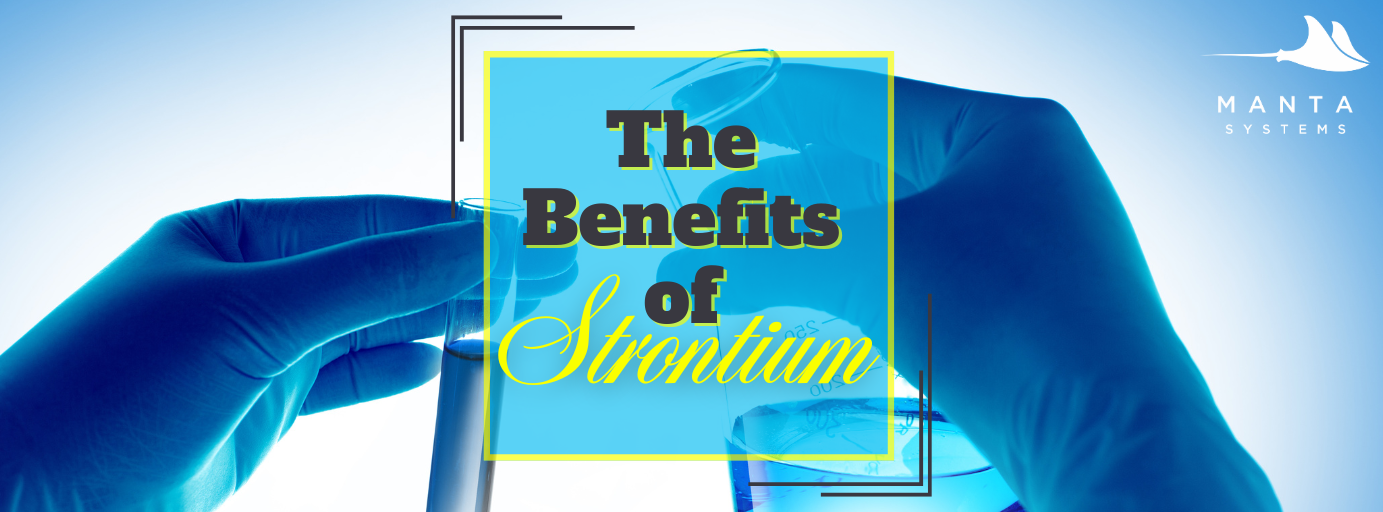
𝐓𝐡𝐞 𝐁𝐞𝐧𝐞𝐟𝐢𝐭𝐬 𝐨𝐟 𝐒𝐭𝐫𝐨𝐧𝐭𝐢𝐮𝐦:
𝐖𝐡𝐲 𝐘𝐨𝐮𝐫 𝐑𝐞𝐞𝐟 𝐓𝐚𝐧𝐤 𝐍𝐞𝐞𝐝𝐬 𝐈𝐭
Updated 4/1/25
Maintaining a successful reef tank involves more than just keeping your calcium and alkalinity in check. One trace element that often flies under the radar but plays a crucial role in coral health is strontium. From skeletal growth to coralline algae development, strontium helps support vibrant, thriving reef systems. In this guide, we’ll break down what strontium does, how to test and supplement it, and what to watch out for.
Let’s get into it!
What is Strontium?
Strontium is a naturally occurring trace element found in seawater at concentrations around 8–10 parts per million (ppm). While it doesn’t get as much spotlight as calcium or alkalinity, strontium plays a quiet but critical role in the structural health of your reef tank's most beloved organisms—especially stony corals, coralline algae, and calcifying invertebrates.
Think of calcium as the cement in a coral’s skeleton—and strontium as the rebar reinforcement. Just as rebar adds strength and durability to concrete, strontium integrates into the aragonite (a form of calcium carbonate) structures that make up coral skeletons and shells, boosting both growth and resilience.
Strontium is chemically similar to calcium, and many reef-building organisms can substitute it into their skeletal matrix. This makes it especially important for small polyp stony (SPS) and large polyp stony (LPS) corals that rely heavily on a stable supply of minerals to grow and maintain their structures. It also supports the vibrant encrusting growth of coralline algae and helps clams and snails develop healthy shells.
While your corals don’t need strontium in large amounts, a consistent supply supports optimal calcification and overall skeletal strength—especially in systems with rapid coral growth or heavy use of calcium-based media.
Tamara’s Pro Tip: Don’t confuse "trace" with "unimportant." Even small amounts of strontium can make a big difference in your reef’s overall vitality.
What Does Strontium Do in a Reef Tank?
1. Supports Skeletal Development in Corals
-
Strontium is absorbed alongside calcium and incorporated into the aragonite skeletons of stony corals (both SPS and LPS species).
-
It helps reinforce the structural integrity of coral branches, plates, and walls—making them less brittle and more resistant to breakage from handling or flow.
-
Strontium is particularly important for fast-growing SPS corals like Acropora and Montipora, where rapid calcification demands more structural minerals.
-
In systems with heavy coral growth or high coral demand, strontium can be rapidly depleted, leading to slower growth or weaker skeletons if not replenished.
Tamara’s Pro Tip: If your Acros seem “stuck” and aren’t encrusting or branching like they used to—even with good calcium and alk—don’t forget about strontium. Sometimes it’s the missing piece.
2. Enhances Coralline Algae Growth
-
Coralline algae, known for its vibrant purple, pink, and red crusty appearance, uses strontium as part of its calcified structure.
-
Healthy coralline algae helps lock in nutrients, outcompete nuisance algae, and add a polished, mature look to your tank.
-
When strontium levels are optimal, you’ll often see faster coralline spread across glass, rockwork, and even pumps.
Tamara’s Pro Tip: Want to encourage coralline growth on new dry rock? Keep calcium, alkalinity, magnesium, and strontium in balance—and add scrapings from established coralline-covered rocks to seed it!
3. Benefits Invertebrates
-
Invertebrates like clams, snails, shrimp, and some crabs use strontium (along with calcium) to build and repair their exoskeletons or shells.
-
Strontium helps harden and reinforce these structures, especially in growing or molting animals.
-
Maintaining strontium helps prevent issues like shell pitting, slow shell growth, or molting problems in crustaceans.
Tamara’s Pro Tip: If you’ve got a bunch of clams or fast-growing SPS, you’re probably burning through strontium faster than you think!
Signs of Strontium Deficiency in Your Reef Tank
Strontium doesn't scream when it’s missing—but it definitely whispers. Many reefers don’t realize their tank is strontium-deficient until things just start looking a little...off. Here's what to watch for:
1. Slower or Stalled Coral Growth
-
SPS corals like Acropora or Montipora may stop encrusting, slow their branching, or plate less aggressively.
-
LPS corals may inflate normally but show little to no skeletal expansion at the base.
-
Corals might look healthy color-wise but remain the same size for months.
-
This is especially noticeable if your calcium, alkalinity, and magnesium are spot-on—but growth still seems sluggish.
Tamara’s Pro Tip: If you’re doing everything “right” and your corals still seem stuck in time, strontium could be the quiet culprit.
2. Fading or Receding Coralline Algae
-
Instead of spreading vibrant purples and pinks, coralline algae might look washed-out, pale, or patchy.
-
You may notice bare spots on rocks or glass where coralline used to dominate.
-
It can begin flaking off, especially under strong flow, or simply stop spreading altogether.
-
In severe cases, nuisance algae like green hair or diatoms may start replacing coralline-covered surfaces.
Tamara’s Pro Tip: Coralline is your tank’s aesthetic armor—it protects surfaces and competes with pests. If it’s fading, your trace elements (especially strontium) need a closer look.
3. Shell or Exoskeleton Issues in Invertebrates
-
Clams, snails, shrimp, and crabs rely on strontium to build and reinforce their shells and exoskeletons.
-
Signs of deficiency include:
-
Pitting or thinning in snail and clam shells
-
Chipped edges or slow shell repair
-
Shrimp and crabs with molting issues or incomplete molts
-
Crustaceans appearing soft or lethargic after molting
-
-
If you’ve ruled out calcium or magnesium issues, strontium is a likely suspect.
Tamara’s Pro Tip: A healthy clam or trochus snail should show clean, shiny new shell growth. If yours look dull or fragile, strontium might be running low.
How to Test Strontium Levels
Ideal Range: 8–10 ppm
I am not affliated with any brand, but these are the ones I personally use.
-
Salifert Strontium Test Kit – Affordable and hobbyist-friendly.
-
Red Sea Reef Foundation Pro Kit – Tests calcium, alkalinity, and magnesium along with strontium.
-
ICP Testing (e.g., ICP-Analysis, Triton) – For ultra-precise results, especially if you’re running a complex system.
Tamara’s Pro Tip: Strontium levels don’t drop as fast as calcium or alkalinity, so test monthly—or more often if you’re running a high-demand system.
Testing and Adjusting Strontium Levels
Strontium isn’t something you need to test every other day, but you do need to keep an eye on it—especially if you’re running a coral-heavy reef tank or dosing trace elements.
1. How Often to Test
-
-
For most mixed reef tanks, testing strontium every 2–4 weeks is sufficient.
-
If you’re dosing strontium directly, or if your corals are growing quickly, it’s smart to test more frequently until you establish a baseline for your tank’s consumption.
-
Once your tank is stable, monthly tests can usually keep you on track.
-
Tamara’s Pro Tip: Overdosing can cause imbalances or interact poorly with other elements like magnesium—keep your adjustments conservative.
2. Adjusting Your Dosage
-
Strontium consumption varies from tank to tank based on coral load, water change habits, and salt mix.
-
Always follow the dosing instructions from your chosen supplement brand. Don't wing it—trace elements are powerful in small amounts.
-
If test results show low strontium:
-
Start with a half-dose of the recommended amount rather than the full dose.
-
Wait 2–3 days, then retest to see how much your tank responded.
-
Adjust future doses accordingly, based on how much was consumed.
-
3. Why Slow and Steady Matters
-
Trace elements like strontium build up over time and don’t dissipate quickly, so overdosing is more dangerous than being slightly under.
-
Rapid changes can stress out sensitive corals and even inhibit calcium uptake.
Tamara’s Pro Tip: When in doubt, less is more with strontium. Use your test results (or ICP data) as your guide, not your dosing pump schedule. And remember: a healthy tank isn’t built on perfection—it’s built on stability.
How to Maintain and Dose Strontium
1. Regular Water Changes (My Go-To Easy Method)
-
In many reef tanks, especially those that aren't SPS-dominant, consistent water changes using a high-quality reef salt will keep your strontium levels in a healthy range.
-
Most reputable reef salt brands are formulated to mimic natural seawater, including trace elements like strontium, iodine, and boron.
-
If your strontium levels are only slightly low, I find it far easier (and safer) to just do a water change rather than chase perfect numbers with a dosing bottle.
-
It also has the added bonus of replenishing a host of other trace elements that corals and inverts consume.
Tamara’s Pro Tip: Don’t overthink it—if your levels are hovering in the 7–9 ppm range and you're not running a heavily stocked SPS tank, switch to a higher quality salt or increasing water changes often does the trick.
2. Strontium Dosing (When You Need a Boost)
-
If your tank is SPS-heavy, or your ICP tests consistently show strontium depletion despite regular water changes, dosing might be necessary.
-
There are a few ways to go about it:
-
Liquid Strontium Additives: Easy to use and widely available. Just follow the dosing instructions and test regularly.
-
Strontium Chloride Powder: A more concentrated option, best for experienced reefers who are comfortable calculating doses.
-
Two-Part or Three-Part Systems: Some advanced reef dosing programs (like Balling or Triton) include strontium as part of their trace element regimen.
-
-
Always start slow—overdosing strontium can throw off other water parameters or stress corals.
Tamara’s Pro Tip: If you're going to dose, use a trusted test kit (like Salifert or Fauna Marin), or better yet, get an occasional ICP test to check strontium levels with precision. Trace elements are tricky—you don’t want to guess.
Conclusion
Strontium may not be the flashiest element in your reef chemistry lineup, but it plays a critical supporting role in coral and invertebrate health. From helping your SPS branches grow stronger to giving your coralline algae that rich purple hue, strontium deserves a spot on your reefkeeping radar.
Test it. Dose it when needed. And watch your reef thrive.
Happy Reefing!
References:
1. Borneman, Eric H. Aquarium Corals: Selection, Husbandry, and Natural History. TFH Publications, 2001.
2. Fossa, Svein A., and Alf Jacob Nilsen. The Modern Coral Reef Aquarium. Volume 4, Birgit Schmettkamp Verlag, 2000.
3. Shimek, Ronald L. Marine Invertebrates: 500+ Essential-to-Know Aquarium Species. TFH Publications, 2004
4. Sprung, Julian, and Charles Delbeek. The Reef Aquarium: Science, Art, and Technology. Vol. 3, Ricordea Publishing, 2005.







.png)